1997 PONTIAC BONNEVILLE run flat
[x] Cancel search: run flatPage 2 of 405
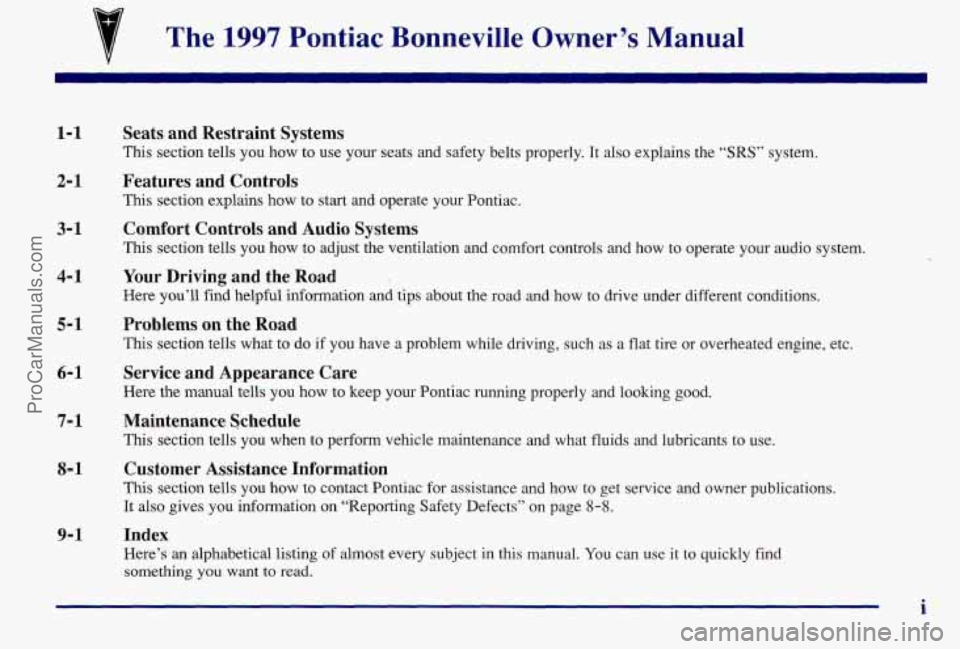
7 The 1997 Pontiac Bonneville Owner’s Manual
1-1
2- 1
3-1
4- 1
5-1
6-1
Seats and Restraint Systems
This section tells you how to use your seats and safety belts properly. It also explains the “SRS’’ system.
Features and Controls
This section explains how to start and operate your Pontiac.
Comfort Controls and Audio Systems
This section tells you how to adjust the ventilation and comfort controls and how to operate your audio system.
Your Driving and the Road
Here you’ll find helpful information and tips about the road and how to drive under different conditions.
Problems on the Road
This section tells what to do if you have a problem while driving, such as a flat tire or overheated engine, etc.
Service and Appearance Care
Here the manual tells you how to keep your Pontiac running properly and looking good.
7-1 Maintenance Schedule
This section tells you when to perform vehicle maintenance and what fluids and lubricants to use.
8- 1
9-1
Customer Assistance Information
This section tells you how to contact Pontiac for assistance and how to get service and owner publications.
It also gives you information on “Reporting Safety Defects” on page
8-8.
Index
Here’s an alphabetical listing of almost every subject in this manual. You can use it to quickly find
something you want to read.
i
ProCarManuals.com
Page 44 of 405
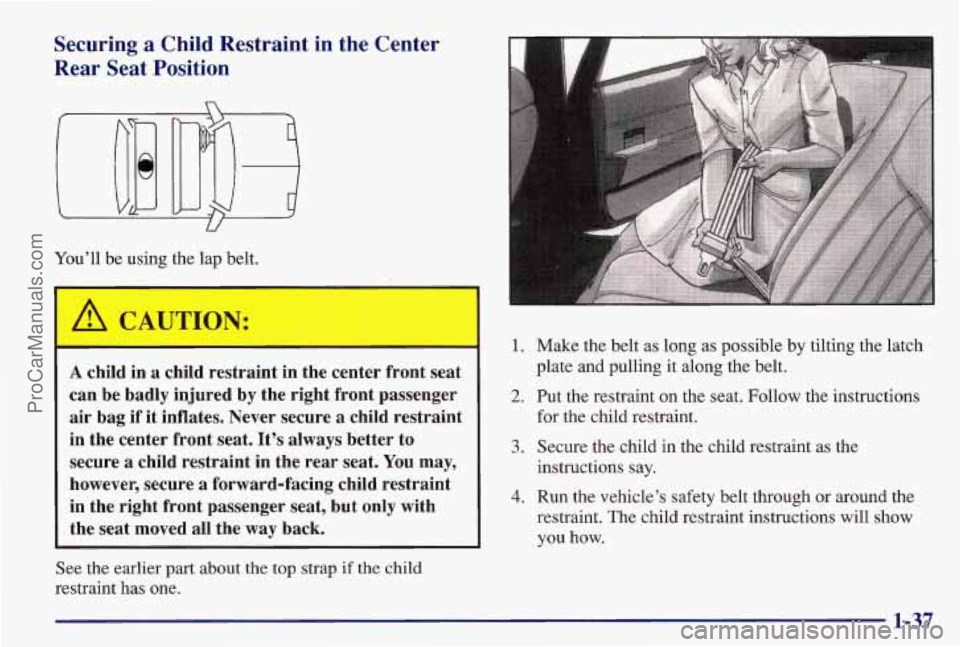
Securing a Child Restraint in the Center
Rear Seat Position
You’ll be using the lap belt.
I
A child in a child restraint in the center front seat
can be badly injured by the right front passenger
air bag if it inflates. Never secure
a child restraint
in the center front seat.
It’s always better to
secure
a child restraint in the rear seat. You may,
however, secure
a forward-facing child restraint
in the right front passenger seat, but only with
the seat moved
all the way back.
See the earlier
part about the top strap if the child
restraint has one.
1. Make the belt as long as possible by tilting the latch
plate and pulling
it along the belt.
2. Put the restraint on the seat. Follow the instructions
for the child restraint.
3. Secure the child in the child restraint as the
instructions say.
4. Run the vehicle’s safety belt through or around the
restraint. The child restraint instructions will show
you
how.
1-37
ProCarManuals.com
Page 46 of 405

Securing a Child Restraint in the Right
Front Seat Position
n
Your vehicle has a right front passenger air bag. Never
put a rear-facing child restraint in this seat. Here’s why:
U
A child in a rear-facing child restraint can be
seriously injured if the right front passenger’s air
bag inflates. This is because the back
of a
rear-facing child restraint would be very close
to
the inflating air bag. Always secure a rear-facing
child restraint in the rear seat.
You’ll be using the lap-shoulder belt. See the earlier part
about the top strap if the child restraint has one.
1. Because your vehicle has a right front passenger air
bag, always move the seat as far back as it will
go
before securing a forward-facing child restraint. (See
“Seats” in the Index.)
2. ht the restraint on the seat. Follow the instructions
for the child restraint.
3. Secure the child in the child restraint as the
instructions say.
4. Pick up the latch plate, and run the lap and shoulder
portions
of the vehicle’s safety belt through or
around the restraint.
The child restraint instructions
will show you how.
If the shoulder belt goes in front of the child’s face or
neck, put it behind the child restraint.
1-39
ProCarManuals.com
Page 54 of 405
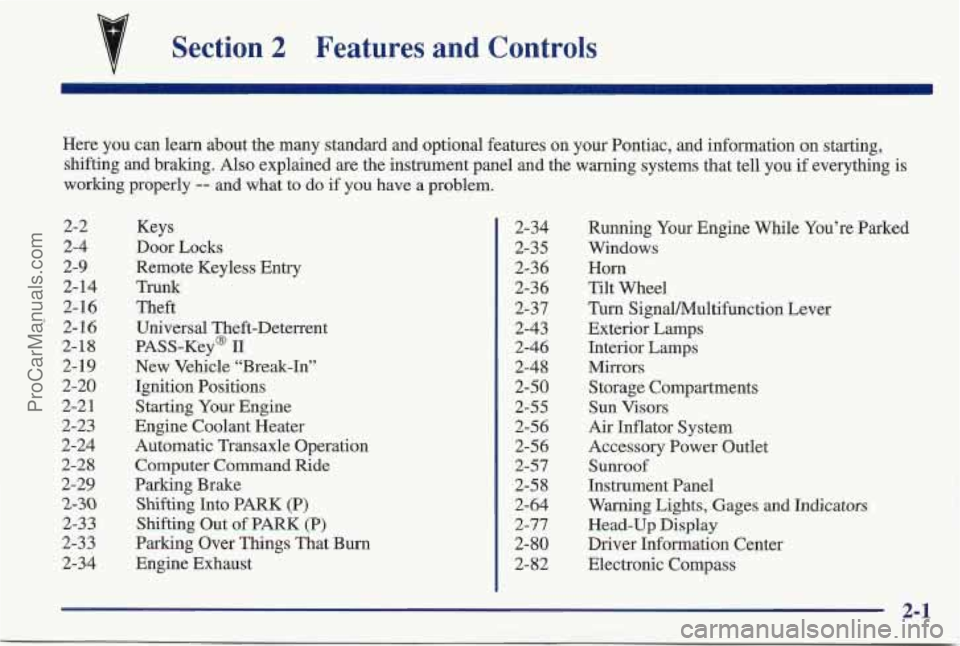
Section 2 Features and Controls
Here you can learn about the many standard and optional features on your Pontiac, and information on starting,
shifting and braking. Also explained are the instrument panel and the warning systems that tell you if everything
is
working properly -- and what to do if you have a problem.
2-2
2-4
2-9
2- 14
2-16
* 2-16
2-18
2-19
2-20
2-2
1
2-23
2-24
2-28
2-29
2-30
2-33
2-33
2-34 Keys
Door Locks
Remote Keyless Entry Trunk
Theft
Universal Theft-Deterrent
PASS-Key@
I1
New Vehicle “Break-In”
Ignition Positions
Starting
Your Engine
Engine Coolant Heater
Automatic Transaxle Operation Computer Command Ride
Parking Brake
Shifting Into PARK (P)
Shifting Out of PARK (P)
Parking Over Things That Bum
Engine Exhaust 2-34
2-3
5
2-3 6
2-36
2-37
1 2-43
~ 2-46
2-48
2-50
2-55
2-56
2-56
2-57
2-5 8
2-64
2-77
2-80
2-82 Running
Your Engine While You’re Parked
Windows
Horn
Tilt Wheel
Turn SignalMultifunction Lever
Exterior Lamps
Interior Lamps
Mirrors
Storage Compartments
Sun Visors
Air Inflator
System
Accessory Power Outlet
Sunroof
Instrument Panel
Warning Lights, Gages
and Indicators
Head-Up Display
Driver Information Center
Electronic Compass
2-.l
ProCarManuals.com
Page 107 of 405
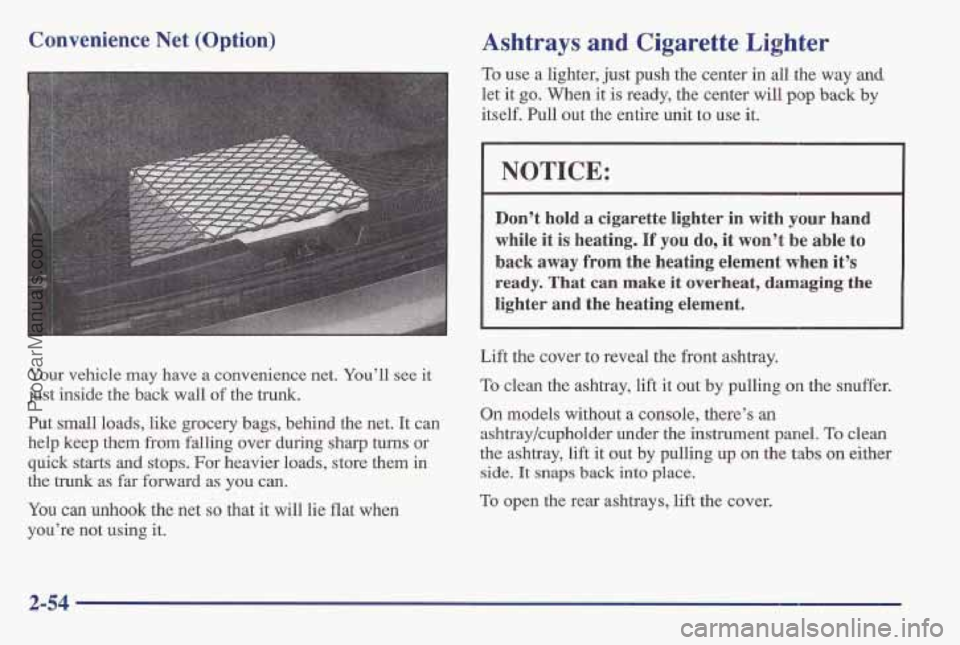
Convenience Net (Option)
Your vehicle may have a convenience net. You’ll see it
just inside the back wall of the trunk.
Put small loads, like grocery bags, behind the net.
It can
help keep them from falling
over during sharp turns or
quick starts
and stops. For heavier loads, store them in
the trunk as far forward as you can.
You can unhook the net so that it will lie flat when
you’re not using
it.
Ashtrays and Cigarette Lighter
To use a lighter, just push the center in all the way and
let it go. When it is ready, the center will pop back by
itself. Pull out the entire unit to use it.
I NOTICE:
Don’t hold a cigarette lighter in with your hand
while it is heating.
If you do, it won’t be able to
back away from the heating element when it’s
ready. That can make it overheat, damaging the
lighter and the heating element.
Lift the cover to reveal the front ashtray.
To clean the ashtray, lift it out by pulling on the snuffer.
On models without a console, there’s an
ashtray/cupholder under the instrument panel.
To clean
the ashtray, lift it out by pulling up
on the tabs on either
side. It snaps back into place.
To open the rear ashtrays, lift the cover.
2-54
ProCarManuals.com
Page 109 of 405
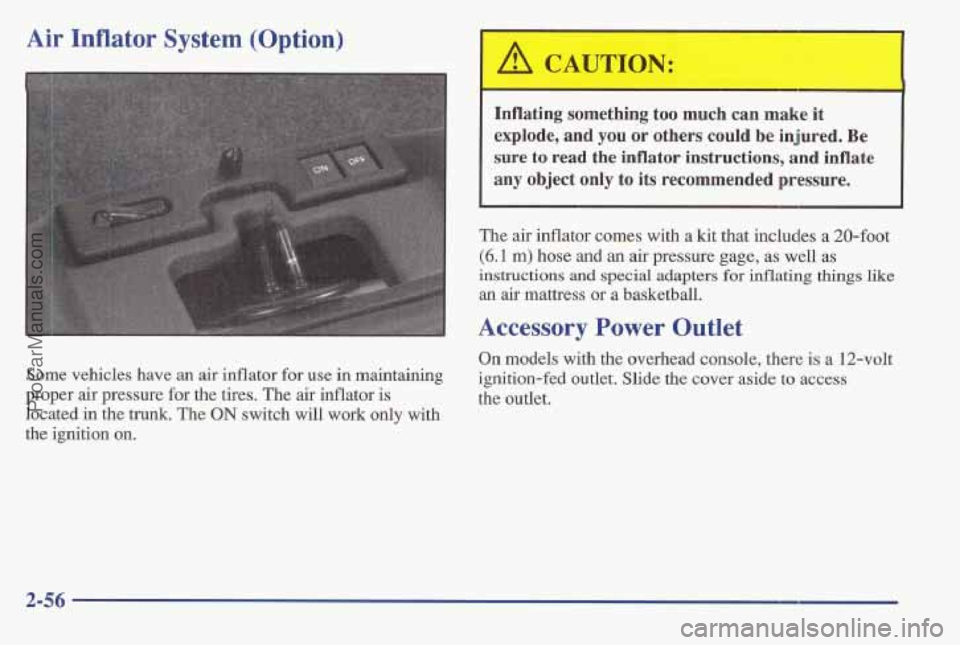
Air Inflator System (Option)
Some vehicles have an air inflator for use in maintaining
proper air pressure for the tires. The air inflator is
located in the
trunk. The ON switch will work only with
the ignition on.
k!, CAUTION:
Inflating something too much can make it
explode, and
you or others could be injured. Be
sure to read the inflator instructions, and inflate
any object only to its recommended pressure.
I I
The air inflator comes with a kit that includes a 20-foot
(6.1 m) hose and an air pressure gage, as well as
instructions and special adapters for inflating things like
an air mattress or a basketball.
Accessory Power Outlet
On models with the overhead console, there is a 12-volt
ignition-fed outlet. Slide the cover
aside to access
the outlet.
2-56
ProCarManuals.com
Page 203 of 405
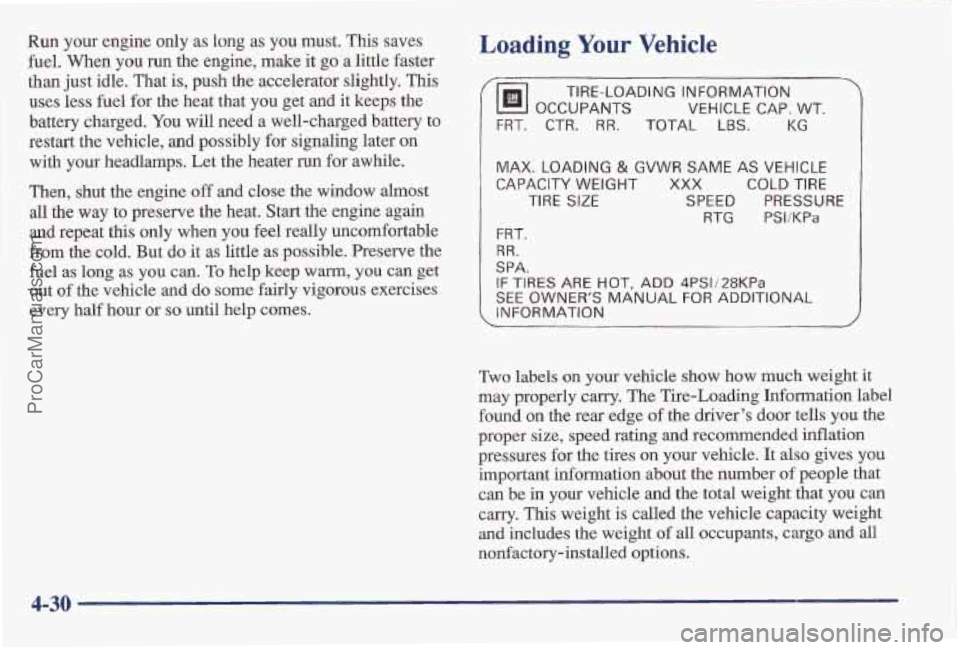
Run your engine only as long as you must. This saves
fuel. When you run the engine, make it go a little faster
than just idle. That is, push the accelerator slightly. This
uses less fuel for the heat that you get and it keeps the
battery charged.
You will need a well-charged battery to
restart the vehicle, and possibly for signaling later on
with your heacllamps. Let the heater run for awhile.
Then, shut the engine
off and close the window almost
all the way to preserve the heat. Start the engine again
and repeat this only when you feel really uncomfortable
from the cold, But do it as little as possible. Preserve the
fuel
as long as you can. To help keep warm, you can get
out
of the vehicle and do some fairly vigorous exercises
every half
hour or so until help comes.
Loading Your Vehicle
OCCUPANTS VEHICLE CAP. WT.
TIRE-LOADING
INFORMATION
FRT, CTR. RR. TOTAL LBS. KG
’ MAX. LOADING & GVWR SAME AS VEHICLE
CAPACITY WEIGHT XXX COLD TIRE
TIRE SIZE SPEED PRESSURE
RTG PSI/KPa
FRT.
RR.
SPA.
IF TIRES ARE HOT, ADD 4PS1/28KPa
SEE OWNER’S MANUAL FOR ADDITIONAL
, INFORMATION
Two labels on your vehicle show how much weight it
may properly carry. The Tire-Loading Information label
found
on the rear edge of the driver’s door tells you the
proper size, speed rating and recommended inflation
pressures for the tires on your vehicle. It
also gives you
important information about the number
of people that
can be
in your vehicle and the total weight that you can
carry. This weight is called the vehicle capacity weight
and includes the weight of all occupants, cargo and all
nonfactory-installed options,
4-30
ProCarManuals.com
Page 249 of 405
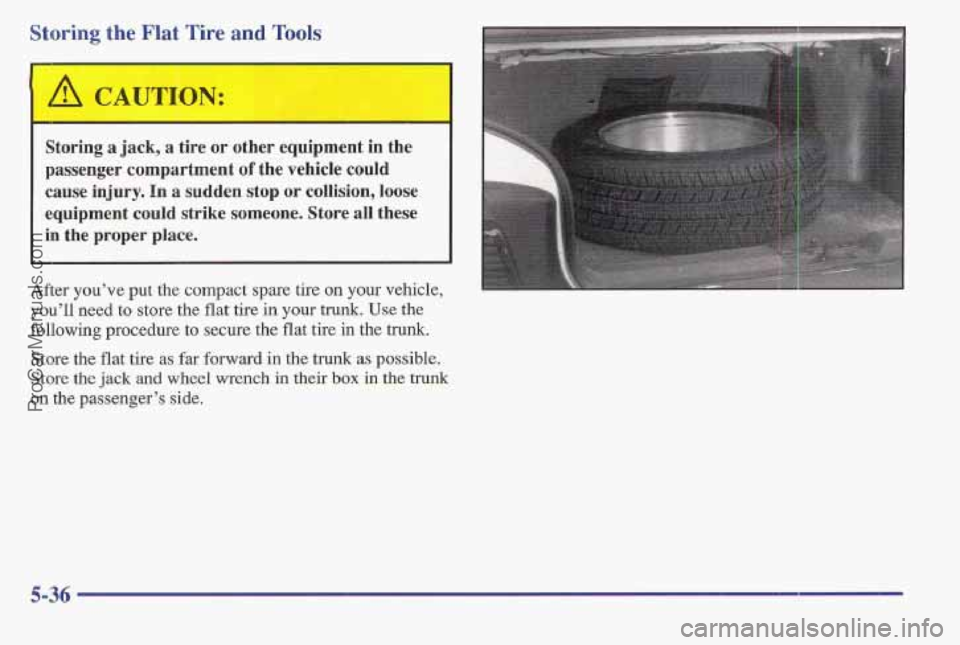
Storing the Flat Tire and Tools
L
Storing a jack, a tire or other equipment in the
passenger compartment of the vehicle could
,cause injury. In a sudden stop or collision, loose
equipment could strike somleone. Store all these
in the proper place.
I
After you’ve put the compact spare tire on your vehicle,
you’ll need to store the flat tire in your trunk. Use the
following procedure to secure the flat tire in the trunk.
Store the flat tire as far forward in the trunk as possible.
Store the jack and wheel wrench in their box in the trunk
on the passenger’s side.
5-36
ProCarManuals.com